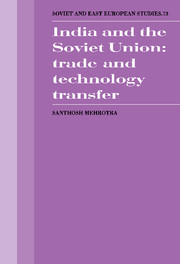8 - Bilateral trade
from PART III
Published online by Cambridge University Press: 04 August 2010
Summary
Indo-Soviet trade had by the early seventies acquired its own dynamic. Indian imports from the USSR up to the mid-sixties were largely supported by utilisation of Soviet developmental credits. Soviet aid utilised by India accounted for over four-fifths of Indian imports from the USSR between 1956/7 and 1960/1, and nearly two-thirds between 1961/2 and 1965/6. However, that share had fallen considerably by the early seventies (see table 8.1). Although the share of development credits repaid as a share of Indian exports to the USSR has not shown a consistently falling trend since the mid-fifties, for most of the period it was well below 20 per cent, falling to under 10 per cent in the eighties. In this sense, one can justifiably argue that Indo-Soviet trade has acquired its own dynamic, and is not determined to any significant extent by India's utilisation and repayment of Soviet loans.
However, the question may still be raised: has bilateral trade with the USSR in the seventies led to trade creation for India or have India's exports merely been diverted from hard currency areas? This question is addressed in section 1. Section 2 considers the commodity composition of Indo-Soviet trade, comparing it to India's trade with the rest of the world, and Soviet trade with other LDCs. Section 3 discusses the stability of India's export earnings from the USSR, comparing it to the stability of India's export earnings from the rest of the world.
- Type
- Chapter
- Information
- India and the Soviet UnionTrade and Technology Transfer, pp. 161 - 206Publisher: Cambridge University PressPrint publication year: 1991



